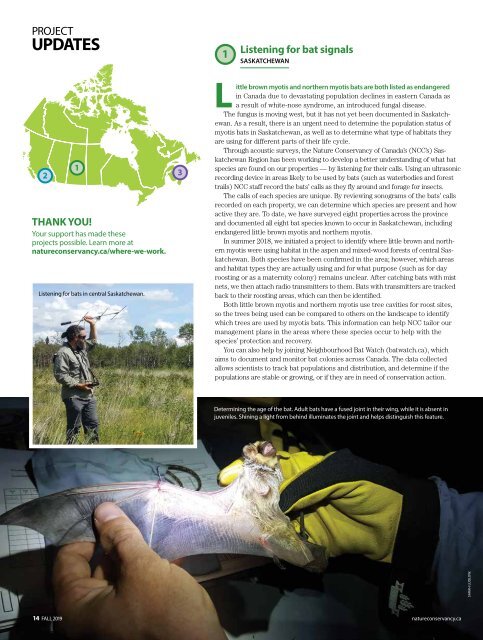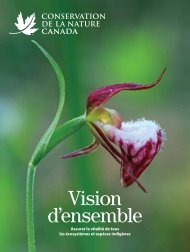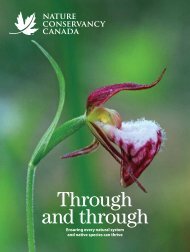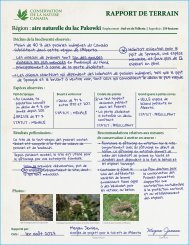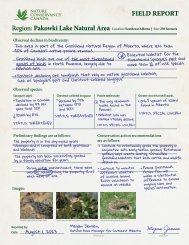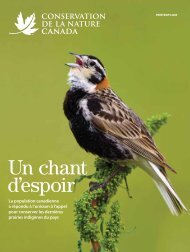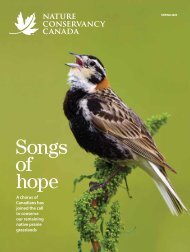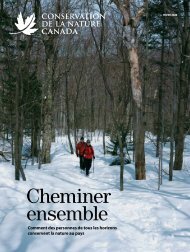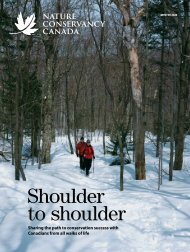NCC Magazine: Fall 2019
You also want an ePaper? Increase the reach of your titles
YUMPU automatically turns print PDFs into web optimized ePapers that Google loves.
PROJECT<br />
UPDATES<br />
1<br />
Listening for bat signals<br />
SASKATCHEWAN<br />
2<br />
1<br />
THANK YOU!<br />
Your support has made these<br />
projects possible. Learn more at<br />
natureconservancy.ca/where-we-work.<br />
Listening for bats in central Saskatchewan.<br />
3<br />
Little brown myotis and northern myotis bats are both listed as endangered<br />
in Canada due to devastating population declines in eastern Canada as<br />
a result of white-nose syndrome, an introduced fungal disease.<br />
The fungus is moving west, but it has not yet been documented in Saskatchewan.<br />
As a result, there is an urgent need to determine the population status of<br />
myotis bats in Saskatchewan, as well as to determine what type of habitats they<br />
are using for different parts of their life cycle.<br />
Through acoustic surveys, the Nature Conservancy of Canada’s (<strong>NCC</strong>’s) Saskatchewan<br />
Region has been working to develop a better understanding of what bat<br />
species are found on our properties — by listening for their calls. Using an ultrasonic<br />
recording device in areas likely to be used by bats (such as waterbodies and forest<br />
trails) <strong>NCC</strong> staff record the bats’ calls as they fly around and forage for insects.<br />
The calls of each species are unique. By reviewing sonograms of the bats’ calls<br />
recorded on each property, we can determine which species are present and how<br />
active they are. To date, we have surveyed eight properties across the province<br />
and documented all eight bat species known to occur in Saskatchewan, including<br />
endangered little brown myotis and northern myotis.<br />
In summer 2018, we initiated a project to identify where little brown and northern<br />
myotis were using habitat in the aspen and mixed-wood forests of central Saskatchewan.<br />
Both species have been confirmed in the area; however, which areas<br />
and habitat types they are actually using and for what purpose (such as for day<br />
roosting or as a maternity colony) remains unclear. After catching bats with mist<br />
nets, we then attach radio transmitters to them. Bats with transmitters are tracked<br />
back to their roosting areas, which can then be identified.<br />
Both little brown myotis and northern myotis use tree cavities for roost sites,<br />
so the trees being used can be compared to others on the landscape to identify<br />
which trees are used by myotis bats. This information can help <strong>NCC</strong> tailor our<br />
management plans in the areas where these species occur to help with the<br />
species’ protection and recovery.<br />
You can also help by joining Neighbourhood Bat Watch (batwatch.ca), which<br />
aims to document and monitor bat colonies across Canada. The data collected<br />
allows scientists to track bat populations and distribution, and determine if the<br />
populations are stable or growing, or if they are in need of conservation action.<br />
Determining the age of the bat. Adult bats have a fused joint in their wing, while it is absent in<br />
juveniles. Shining a light from behind illuminates the joint and helps distinguish this feature.<br />
SARAH LUDLOW.<br />
14 FALL <strong>2019</strong> natureconservancy.ca


